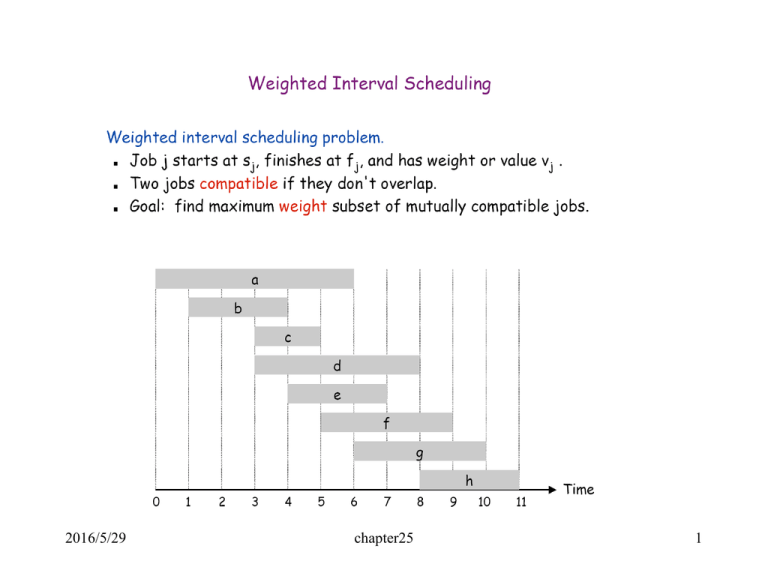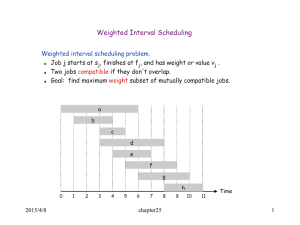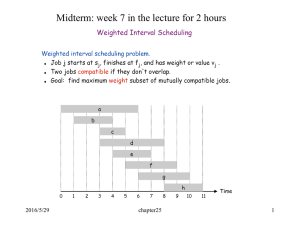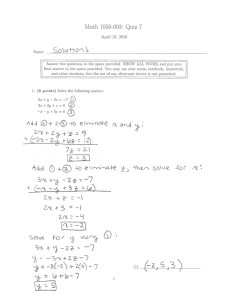2016/5/29 chapter25 1
advertisement

2016/5/29
chapter25
1
2016/5/29
chapter25
2
2016/5/29
chapter25
3
2016/5/29
chapter25
4
Index
1
2
v1=2
p(1)=0
v2=4
p(2)=0
v3=4
p(3)=1
3
4
v4=7
p(4)=0
v5=2
5
v6=1
6
2016/5/29
chapter25
p(5)=3
p(6)=3
5
Weighted Interval Scheduling: Bottom-Up
Input: n, s1, s2, …, sn, f1, f2, …, fn, v1, v2, …, vn
Sort jobs by finish times so that f1f2 … fn.
Compute p(1), p(2) , …, p(n)
M[0]=0;
for j = 1 to n do
M[j] = max { vj+m[p(j)], m[j-1]}
if (M[j] == M[j-1]) then B[j]=0 else B[j]=1 /*for backtracking
m=n; /*** Backtracking
while ( m ≠0) { if (B[m]==1) then
print job m; m=p(m)
else
2016/5/29
m=m-1 }
B[j]=0 indicating job j is not selected.
B[j]=1 indicating job j is selected.
chapter25
6
Index
1
w1=2
2
3
4
5
2
0
2
4
0
2
4
6
0
2
4
6
7
0
2
4
6
7
8
0
2
4
6
7
8
6
p(3)=1
w4=7
4
M= 0
p(2)=0
w3=4
3
1
p(1)=0
w2=4
2
0
p(4)=0
w5=2
5
w6=1
6
p(5)=3
p(6)=3
M[j] = max { vj+m[p(j)], m[j-1]}
M[2]=w2+M[0]=4+0; M[3]=w3+M[1]=4+2;
M[4]=W4+M[0]=7+0; M[5]=W5+M[3]=2+6;
M[6]=w6+M[3]=1+6<8;
j: 0 1 2 3 4 5 6
Backtracking: job1, job 3, job 5
B: 0 1 1 1 1 1 0
2016/5/29
chapter25
7
8
Backtracking and time complexity
•Backtracking is used to get the schedule.
•P()’s can be computed in O(n) time after sorting all the jobs
based on the starting times.
•Time complexity
• O(n) if the jobs are sorted and p() is computed.
• Total time: O(n log n) including sorting.
2016/5/29
chapter25
8
Computing p()’s in O(n) time
P()’s can be computed in O(n) time using two sorted lists, one
sorted by finish time (if two jobs have the same finish time,
sort them based on starting time) and the other sorted by start
time.
Start time: b(0, 5), a(1, 3), e(3, 8), c(5, 6), d(6, 8)
Finish time a(1, 3), b(0,5), c(5,6), d(6,8), e(3,8)
P(d)=c, p(c )=b, p(e)= a, p(a)=0, p(b)=0. (See demo7)
2016/5/29
chapter25
9
Example 2:
Start time: b(0, 5), a(1, 3), e(3, 8), c(5, 6), d(6, 8)
Finish time a(1, 3), b(0,5), c(5,6), d(6,8), e(3,8)
P(d)=c, p(c )=b, p(e)= a, p(a)=0, p(b)=0.
v(a)=2, v(b)=3, v(c )=5, v(d) =6, v(e)=8.8.
Solution: M[0]=0, M[a]=2. M[b]=max{2, 3+M[p(b)]}=3.
M[c]=max{3, 5+M[p(c )]}=5+M[b]=8.
M[d]=max{8, 6+M[p(d)]}=6+M[c]=6+8=14.
M[e]=max{14, 8.8+M[p(e)]}=max{14, 8.8+M[a]}=max {14, 10.8}=14.
Backtracking: b, c, d.
2016/5/29
Job: a b c d e
chapter25
B: 1 1 1 1 0
10
Longest common subsequence
• Definition 1: Given a sequence X=x1x2...xm,
another sequence Z=z1z2...zk is a subsequence of
X if there exists a strictly increasing sequence
i1i2...ik of indices of X such that for all j=1,2,...k,
we have xij=zj.
• Example 1: If X=abcdefg, Z=abdg is a
subsequence of X.
X=abcdefg,
Z=ab d g
2016/5/29
chapter25
11
• Definition 2: Given two sequences X and Y,
a sequence Z is a common subsequence of
X and Y if Z is a subsequence of both X
and Y.
• Example 2: X=abcdefg and Y=aaadgfd.
Z=adf is a common subsequence of X and
Y.
X=abc defg
Y=aaaadgfd
Z=a d f
2016/5/29
chapter25
12
• Definition 3: A longest common
subsequence of X and Y is a common
subsequence of X and Y with the longest
length. (The length of a sequence is the
number of letters in the sequence.)
• Longest common subsequence may not
be unique.
• Example: abcd
acbd
Both acd and abd are LCS.
2016/5/29
chapter25
13
Longest common subsequence problem
• Input:
Two sequences X=x1x2...xm, and
Y=y1y2...yn.
• Output: a longest common subsequence of X and Y.
• Applications:
• Similarity of two lists
– Given two lists: L1: 1, 2, 3, 4, 5 , L2:1, 3, 2, 4, 5,
– Length of LCS=4 indicating the similarity of the two lists.
• Unix command “diff”.
2016/5/29
chapter25
14
Longest common subsequence problem
• Input:
Two sequences X=x1x2...xm, and
Y=y1y2...yn.
• Output: a longest common subsequence of X and Y.
• A brute-force approach
Suppose that mn. Try all subsequence of X
(There are 2m subsequence of X), test if such a
subsequence is also a subsequence of Y, and select
the one with the longest length.
2016/5/29
chapter25
15
Charactering a longest common
subsequence
• Theorem (Optimal substructure of an
LCS)
• Let X=x1x2...xi, and Y=y1y2...yj be two sequences, and
• Z=z1z2...zk be any LCS of X and Y.
• 1. If xi=yj, then zk=xi=yj and Z[1..k-1] is an LCS of
X[1..m-1] and Y[1..n-1].
• 2. If xi yj, then zkxi implies that Z is an LCS of X[1..i-1]
and Y.
• 2. If xi yj, then zkyjimplies that Z is an LCS of X and
Y[1..j-1].
2016/5/29
chapter25
16
The recursive equation
• Let c[i,j] be the length of an LCS of X[1...i] and
Y[1...j].
• c[i,j] can be computed as follows:
0
if i=0 or j=0,
c[i,j]= c[i-1,j-1]+1
if i,j>0 and xi=yj,
max{c[i,j-1],c[i-1,j]} if i,j>0 and xiyj.
Computing the length of an LCS
• There are nm c[i,j]’s. So we can compute them in
a specific order.
2016/5/29
chapter25
17
The algorithm to compute an LCS
•
•
•
•
•
•
•
•
•
•
•
•
•
•
•
•
1. for i=1 to m do
2.
c[i,0]=0;
3. for j=0 to n do
4.
c[0,j]=0;
5. for i=1 to m do
6.
for j=1 to n do
7.
{
8.
if x[i] ==y[j] then
9.
c[i,j]=c[i-1,j-1]+1;
10
b[i,j]=1;
11.
else
if c[i-1,j]>=c[i,j-1] then
12.
c[i,j]=c[i-1,j]
13.
b[i,j]=2;
14.
else c[i,j]=c[i,j-1]
15.
b[i,j]=3;
14
}
2016/5/29
chapter25
18
Example 3: X=BDCABA and Y=ABCBDAB.
2016/5/29
yi
B
D
C
A
B
A
xi
0
0
0
0
0
0
0
A
0
0
0
0
1
1
1
B
0
1
1
1
1
2
2
C
0
1
1
2
2
2
2
B
0
1
1
2
2
3
3
D
0
1
2
2
2
3
3
A
0
1
2
2
3
3
4
B
0
1
2
2
3
4
4
chapter25
19
Constructing an LCS (back-tracking)
• We can find an LCS using b[i,j]’s.
• We start with b[n,m] and track back to some cell b[0,i] or b[i,0].
• The algorithm to construct an LCS (backtracking)
1.
2.
3.
4.
i=m
j=n;
if i==0 or j==0 then exit;
if b[i,j]==1 then
{
i=i-1;
j=j-1;
print “xi”;
}
5. if b[i,j]==2
i=i-1
6. if b[i,j]==3
j=j-1
7. Goto Step 3.
• The time complexity: O(nm).
2016/5/29
chapter25
20
Remarks on weighted interval scheduling
• it takes long time to explain. (50+13 minutes)
• Do not mention exponent time etc.
• For the first example, use the format of example
2 to show the computation process (more
clearly).
2016/5/29
chapter25
21
Shortest common supersequence
• Definition: Let X and Y be two sequences. A
sequence Z is a supersequence of X and Y if both
X and Y are subsequences of Z.
• Shortest common supersequence problem:
Input: Two sequences X and Y.
Output: a shortest common supersequence of X and Y.
• Example: X=abc and Y=abb. Both abbc and
abcb are the shortest common supersequences for
X and Y.
2016/5/29
chapter25
22
Recursive Equation:
• Let c[i,j] be the length of an SCS of X[1...i]
and Y[1...j].
• c[i,j] can be computed as follows:
j
if i=0
i
if j=0,
c[i,j]= c[i-1,j-1]+1
if i,j>0 and xi=yj,
min{c[i,j-1]+1,c[i-1,j]+1} if i,j>0 and xiyj.
2016/5/29
chapter25
23
2016/5/29
chapter25
24
The pseudo-codes
for i=0 to n do
c[i, 0]=i;
for j=0 to m do
c[0,j]=j;
for i=1 to n do
for j=1 to m do
if (xi == yj) c[i ,j]= c[i-1, j-1]+1; b[i.j]=1;
else {
c[i,j]=min{c[i-1,j]+1, c[i,j-1]+1}.
if (c[I,j]=c[i-1,j]+1 then b[I,j]=2;
else b[I,j]=3;
}
p=n, q=m; / backtracking
while (p≠0 or q≠0)
{ if (b[p,q]==1) then {print x[p]; p=p-1; q=q-1}
if (b[p,q]==2) then {print x[p]; p=p-1}
if (b[p,q]==3) then {print y[q]; q=q-1}
}
2016/5/29
chapter25
25
Example SCS for X=BDCABA and Y=ABCBDAB.
2016/5/29
yi
B
D
C
A
B
A
xi
0
1
2
3
4
5
6
A
1
2
3
4
4
5
6
B
2
2
3
4
5
5
6
C
3
3
4
4
5
6
7
B
4
4
5
5
6
6
7
D
5
5
5
6
7
7
8
A
6
6
6
6
7
8
8
B
7
7
7
7
8
8
9
7+6-4 (LCS)=9 (SCS) see slide 23
chapter25
26
Exercises
•
Exercise 1: For the weighted interval scheduling
problem, there are eight jobs with starting time and finish
time as follows: j1=(0, 8), j2=(2, 3), j3=(3, 6), j4=(5, 9),
j5=(8, 12), j6=(9, 11), j7=(10, 13) and j8=(11, 16). The
weight for each job is as follows: v1=3.5, v2=2.0, v3=3.0,
v4=3.0, v5=6.5, v6=2.5, v7=12.0, and v8=8.0.
Find a maximum weight subset of mutually compatible
jobs. (Backtracking process is required.) (You have to
compute p()’s. The process of computing p()’s is NOT
required.)
• Exercise 2: Let X=abbacab and Y=baabcbb. Find the
longest common subsequence for X and Y.
Backtracking process is required.
2016/5/29
chapter25
27
Summary of Week 7
• Understand the algorithms for the weighted
Interval Scheduling problem, LCS and SCS.
.
2016/5/29
chapter25
28




